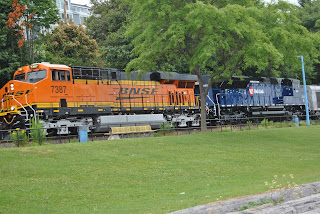Study's price tag signals high costs ahead, if rail line moved off waterfront
Frank Bucholtz photo
The Burlington Northern Santa Fe Railway hosts a wide variety of trains on its line through White Rock, including this special passenger train operated for Dennis and Phyllis Washington and their guests, which travelled through in July 2014. The Washingtons' company, The Washington Group, owns Montana Rail Link, Southern Railway of B.C. and Seaspan International, among other companies.
A proposed $700,000 technical study to look into moving the Burlington Northern Santa Fe tracks from the White Rock and South Surrey waterfront to a new alignment is an early indicator of how costly this idea is.
Municipal politicians are already trying to shift the cost onto their neighbours. Surrey Mayor Linda Hepner says that White Rock should foot a significant portion of the cost, while beleaguered White Rock taxpayers likely think Surrey should pay for all but the consultant’s last cup of coffee.
A move could benefit the waterfront residents of both communities, and if it ever takes place, the corridor should become a seawall similar to the Stanley Park causeway in Vancouver.
However, that’s a big if.
BNSF points out it has spent millions in upgrading the line in recent years, including an expensive new bridge where the line crosses the Serpentine River. That bridge alone has cost about $15 million. It has also replaced the Little Campbell River trestle, which was in poor repair.
Hepner says that, if any line realignment goes ahead, the new rail line would have to be underground for its entire length. Given that a relatively short piece of underground SkyTrain line along the Broadway corridor in Vancouver is proposed to cost close to $2 billion, it’s a reasonable guess that the cost for an underground line from the U.S. border to Cloverdale, a distance of more than 10 kilometres, would cost more than $5 billion. That is assuming that soil conditions in the low-lying farm area south of Cloverdale wouldn’t lead to significant additional costs.
Where is this money coming from? BNSF certainly isn’t going to pay for the line relocation. It already has an existing line which it has spent millions in maintaining and upgrading each year.
Local taxpayers could not afford even a one-third share of a $5 billion project, as is required in most federal-provincial infrastructure projects.
Would the federal and provincial governments be willing to come up with their thirds? That is debatable, given the long list of pressing infrastructure needs such as transit improvements in the Vancouver and Toronto areas, and replacement of crumbling bridges and overpasses in the Montreal area.
What is needed even more than a technical study, at this point, is a thorough cost-benefit analysis. This does not have to be overly technical, but it does need to take into account all factors.
BNSF is criticized for running coal trains to Roberts Bank. The likelihood is that these trains won’t be running all that much longer, given that even China agrees that coal-fired electricity plants need to be eventually phased out.
Hazardous goods will be hauled on any train, no matter where it goes. A tunnel does not guarantee there won’t be a derailment. BNSF has proven to be a good operator, with no derailments along the waterfront line for many years.
There is an significant problem at Crescent Beach, with emergency services unable to get into the residential area if a train blocks the tracks. That can be solved with an overpass - a far cheaper alternative to a 10-kilometre tunnel.
Amtrak passengers would benefit from travel time savings if there was a direct line from Blaine to Cloverdale. However, the time saving would likely be no more than 10 to 15 minutes - not much for a trip that now takes about four hours from Seattle to Vancouver.
Surrey and White Rock would benefit if the waterfront property could become a regional park and trail. However, BNSF is the owner of that land and won’t give it up for nothing. And what would happen to White Rock’s lucrative pay parking on BNSF property? A new owner of that land might want to put it to other uses.
These are some of the advantages and disadvantages of a possible new route. There are many others.
It is important that any relocation move be driven by facts, not rumours or feelings. It is also important that taxpayers be kept in the loop from the beginning, as any relocation project will cost them dearly. They need to be convinced that such a project is a good use of tax dollars.
This week's column in Surrey-North Delta Leader and Peace Arch News
The Burlington Northern Santa Fe Railway hosts a wide variety of trains on its line through White Rock, including this special passenger train operated for Dennis and Phyllis Washington and their guests, which travelled through in July 2014. The Washingtons' company, The Washington Group, owns Montana Rail Link, Southern Railway of B.C. and Seaspan International, among other companies.
A proposed $700,000 technical study to look into moving the Burlington Northern Santa Fe tracks from the White Rock and South Surrey waterfront to a new alignment is an early indicator of how costly this idea is.
Municipal politicians are already trying to shift the cost onto their neighbours. Surrey Mayor Linda Hepner says that White Rock should foot a significant portion of the cost, while beleaguered White Rock taxpayers likely think Surrey should pay for all but the consultant’s last cup of coffee.
A move could benefit the waterfront residents of both communities, and if it ever takes place, the corridor should become a seawall similar to the Stanley Park causeway in Vancouver.
However, that’s a big if.
BNSF points out it has spent millions in upgrading the line in recent years, including an expensive new bridge where the line crosses the Serpentine River. That bridge alone has cost about $15 million. It has also replaced the Little Campbell River trestle, which was in poor repair.
Hepner says that, if any line realignment goes ahead, the new rail line would have to be underground for its entire length. Given that a relatively short piece of underground SkyTrain line along the Broadway corridor in Vancouver is proposed to cost close to $2 billion, it’s a reasonable guess that the cost for an underground line from the U.S. border to Cloverdale, a distance of more than 10 kilometres, would cost more than $5 billion. That is assuming that soil conditions in the low-lying farm area south of Cloverdale wouldn’t lead to significant additional costs.
Where is this money coming from? BNSF certainly isn’t going to pay for the line relocation. It already has an existing line which it has spent millions in maintaining and upgrading each year.
Local taxpayers could not afford even a one-third share of a $5 billion project, as is required in most federal-provincial infrastructure projects.
Would the federal and provincial governments be willing to come up with their thirds? That is debatable, given the long list of pressing infrastructure needs such as transit improvements in the Vancouver and Toronto areas, and replacement of crumbling bridges and overpasses in the Montreal area.
What is needed even more than a technical study, at this point, is a thorough cost-benefit analysis. This does not have to be overly technical, but it does need to take into account all factors.
BNSF is criticized for running coal trains to Roberts Bank. The likelihood is that these trains won’t be running all that much longer, given that even China agrees that coal-fired electricity plants need to be eventually phased out.
Hazardous goods will be hauled on any train, no matter where it goes. A tunnel does not guarantee there won’t be a derailment. BNSF has proven to be a good operator, with no derailments along the waterfront line for many years.
There is an significant problem at Crescent Beach, with emergency services unable to get into the residential area if a train blocks the tracks. That can be solved with an overpass - a far cheaper alternative to a 10-kilometre tunnel.
Amtrak passengers would benefit from travel time savings if there was a direct line from Blaine to Cloverdale. However, the time saving would likely be no more than 10 to 15 minutes - not much for a trip that now takes about four hours from Seattle to Vancouver.
Surrey and White Rock would benefit if the waterfront property could become a regional park and trail. However, BNSF is the owner of that land and won’t give it up for nothing. And what would happen to White Rock’s lucrative pay parking on BNSF property? A new owner of that land might want to put it to other uses.
These are some of the advantages and disadvantages of a possible new route. There are many others.
It is important that any relocation move be driven by facts, not rumours or feelings. It is also important that taxpayers be kept in the loop from the beginning, as any relocation project will cost them dearly. They need to be convinced that such a project is a good use of tax dollars.




NIce Blog!
ReplyDeleteRailings maple ridge Surrey
Awesome Blog
ReplyDeleteVisit Us
handrail vancouver
Awesome Detailed Blog
ReplyDeleteTry Reaching Out To Us
Best Mortgage Broker in Vancouver